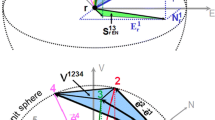Abstract
GPS positioning is often assimilated to trilateration and even to triangulation methods. Both comparisons are wrong because GPS observations are pseudoranges containing clock errors. The geometric interpretations of GPS relative positioning and trilateration method are presented. Receiver clock parameter is also analyzed from a geometric point of view. The generalization of positioning solutions is made without and with observations redundancy. The geometry of the propagation of systematic errors into positioning solutions is also shown, especially the tropospheric (and the ionospheric) delay.






Similar content being viewed by others
References
Allan AL (2007) Principles of geospatial surveying. CRC Press, Boca Raton
ANM (1938) Admiralty navigation manual, vol 3—chapter 13: errors in position lines
Apostol TM, Mnatsakanian MA (2006) Solids circumscribing spheres. Math Assoc Am 113:521–522
Beutler G, Bauersima I, Gurtner W, Rothacher M, Schildknecht T, Geiger A (1988) Atmospheric refraction and some other important biases in GPS carrier phase observations. Atmospheric effects on geodetic space measurements, School of Surveying Monograph No. 12. UNSW, Sydney, pp 15–43
Eberly DH (2008) Distance from linear component to tetrahedron. www.geometrictools.com
Font-Llagunes JM, Batlle JA (2009) New method that solves the three-point resection problem using straight lines intersection. J Surv Eng 135(2):39–45
Fresnel J (1996) Méthodes modernes en géométrie. Hermann, Paris
Geiger A (1988) Simulating disturbances in GPS by continuous satellite distribution. J Surv Eng 114(4):182–194
Morales JJ, Khalife JJ, Kassas ZM (2016) GNSS vertical dilution of precision reduction using terrestrial signals of opportunity. In: Proceedings of ITM ION 2016, Institute of Navigation, Monterey, California, USA, 25–28 Jan, pp 664–669
Santerre R, Geiger A (1998) Geometrical interpretation of GPS positioning with single, double and triple difference carrier phase observations. In: Proceedings of the symposium on geodesy for geotechnical and structural engineering, Eisenstadt, Austria, 20–22 April, pp 465–470
Santerre R, Geiger A, Banville S (2017) Geometry of GPS dilution of precision: revisited. GPS Solut 21(4):1747–1763
Vanicek P, Langley RB, Wells DE, Delikaraoglou D (1984) Geometrical aspects of differential GPS positioning. Bull Géod 58:37–52
Acknowledgements
The first author would like to acknowledge NSERC (Natural Sciences and Engineering Research Council of Canada) for financial support of his GPS research.
Author information
Authors and Affiliations
Corresponding author
Rights and permissions
About this article
Cite this article
Santerre, R., Geiger, A. Geometry of GPS relative positioning. GPS Solut 22, 50 (2018). https://doi.org/10.1007/s10291-018-0713-2
Received:
Accepted:
Published:
DOI: https://doi.org/10.1007/s10291-018-0713-2




